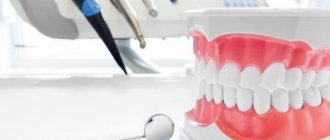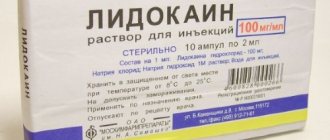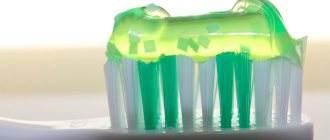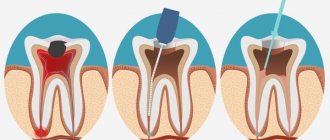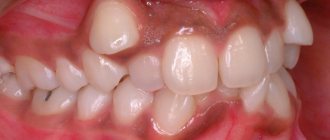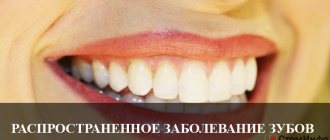2966
The “shark teeth” anomaly is not such a harmless joke of nature as it might seem.
It not only causes psychological and physical discomfort to a person, but can also lead to serious consequences for the dental system.
To get rid of it, you may need the help of not only a dental surgeon, but also an orthodontist.
Causes
A child's first teeth erupt in a certain order, starting at about six months of age. There are deviations in one direction or another, which is due to a number of factors (climate, drinking water) and the individual characteristics of the baby. For some, they appear as early as 1.5 months, for others - closer to a year. They fall out in the same sequence and are replaced with permanent ones. Complete replacement of the dentition occurs on average at the age of 12-13 years.
But there are also situations when permanent teeth begin to grow right next to the second row of milk teeth. If they are located in parallel, then this is called “shark teeth”. The name was coined by analogy with the anatomical feature of sharks. These predators have teeth arranged in three rows.
Possible reasons:
- genetics;
- improper formation of tooth germs during intrauterine development;
- rickets;
- infectious diseases (sinusitis, tonsillitis, adenoiditis).
Shark teeth in humans - is it as harmless as many claim?
2307
The “shark teeth” anomaly is not such a harmless joke of nature as it might seem.
It not only causes psychological and physical discomfort to a person, but can also lead to serious consequences for the dental system.
To get rid of it, you may need the help of not only a dental surgeon, but also an orthodontist.
Interfering milk jug
Most often, after an examination, the dentist recommends removing the milk jug. After this, often even correction of the position of the permanent tooth is not required. It spontaneously shifts to the vacant space. If this still does not happen, it is forcibly displaced.
The correction is carried out by an orthodontist, who directs the growth of the problem element in the desired direction using a system of braces, a removable orthodontic device or a mouthguard.
Sometimes the doctor advises to wait until the “milk jug” falls out on its own, and further decisions are made depending on the clinical situation.
Typically, “milk jugs” are removed when the apex of a permanent first or second molar appears. Their extraction is most often carried out in pairs. For example, two lateral or front incisors are removed at once. This approach promotes the formation of a normal bite.
The exception to the rule is deciduous canines. They should be removed by the age of 11-13, otherwise the bite may be disrupted. Removal before this time is carried out only for serious indications.
Underdevelopment of the jaw
This defect is called micrognathia (in the case of an abnormality of the upper jaw) or microgenia (if the lower jaw is defective).
Eliminating double rows of teeth with an underdeveloped jaw is a more complex and lengthy process than the case of removing an interfering “milk jug.” It can take up to six months or more.
It is possible to stimulate the growth of an underdeveloped jaw only with the help of removable and non-removable orthodontic devices.
The choice of device is individual and depends on the characteristics of the clinical situation. The difficulty of correcting an underdeveloped jaw is determined by the patient’s young age. Children, more than adults, are burdened by the devices installed in their mouths, and cannot properly care for them.
A good treatment option is the Invisalign system, which is an elastic mouth guard. It is unnoticeable, easily removed and put on during oral care. Its only drawback is its high cost.
Hyperdontia
Supernumerary teeth are removed in most cases. Together with them, complete, incorrectly located units are sometimes subjected to extraction.
The sequence for removing a supernumerary tooth is as follows:
- X-rays of the jaws are taken to determine the position of not only the erupted teeth, but also their rudiments.
- Local anesthesia is administered. In special cases, general anesthesia cannot be ruled out.
- The problematic tooth is removed. If it is impacted, then when removed, the surface of the gum is exposed (usually from the side of the tongue).
- The surgical wound is sutured (if required).
Sometimes the condition of a supernumerary tooth turns out to be better than that of the complete tooth next to it. In this case, a decision may be made to leave it and remove the complete one.
After removing all excess teeth, it is necessary to monitor the growth of the remaining units. If correction of their position is required, it is carried out using orthodontic devices.
The eruption and growth of supernumerary units located deep in the jaw bone can be accelerated by physical therapy (electrophoresis, fluctuarization) or massaging the alveolar process.
If extra teeth erupt before the age of six months, they must be removed immediately so that they do not injure the mother’s breasts or interfere with feeding.
Why is it dangerous?
Despite the unattractive appearance of such a smile, there is no need to worry. Most often, dentists advise not to take any action. The root of the baby tooth softens, and the tooth falls out on its own after a certain period of time. The child facilitates this by loosening the tooth with his tongue or hands.
Sometimes there are situations when the root is too strong. If the process takes too long, you can go to the dentist to remove the unnecessary vestige. After the manipulation, the permanent tooth will gradually move to the place of the removed one and become attached to it. The tongue is a very powerful muscle. Under its pressure, the dentition is properly aligned in about a month. No additional equipment or effort is required.
Shark skin is a predator's second teeth
Shark skin, like teeth, is also highly prized. This is one of the few materials that is not susceptible to mechanical stress. It is almost twice as strong as oxen - it can withstand a force of 500 kg/cm.
Therefore, products made from shark skin are considered eternal.
Today, shark skin is considered ideal for the production of shagreen. Despite its thickness and apparent rigidity, it lends itself well to dressing and tanning. To grind off sharp placoid scales, carborundum sharpeners are usually used.
Different species of sharks have skin of varying thickness and thickness. Huge pieces of skin of large species, such as whale skin or great white, are used for sewing shoes and upholstering expensive furniture.
Smaller species, such as fox and sand, give their skin to the production of purses, belts, wallets and other accessories. In Europe, cases for precious jewelry made from shark shagreen are considered classics.
In addition, dried shark skin, which resembles emery, is used to polish various types of wood, marble, and comb felt.
Shark skin, because it is extremely dense, does not absorb dyes well. Therefore, the cost of dyeing increases the cost of the product by half.
Watch video - Shark skin:
In what cases should you consult a doctor?
If the process is accompanied by unpleasant sensations and the child constantly complains, then you should not delay a visit to a specialist. It is recommended to consult a doctor in the following cases:
- The baby tooth does not fall out within three months after the permanent one appears;
- an inflammatory process develops;
- The baby tooth is very loose, causing anxiety and discomfort to the child.
The importance of proper breathing
Nasal breathing helps the jaws develop anatomically correctly. If you breathe through your mouth, there is a high risk of their underdevelopment. This fact can easily be explained by the fact that the tongue plays an important role in the formation of the jaws. In the first case, he takes the desired position. In the second case, the tongue is located at the bottom of the oral cavity and practically does not come into contact with the elements of the jaw arches. They do not develop properly and there is not enough space for permanent teeth.
The parents' job is to closely monitor their child's breathing. If nasal breathing is impaired during colds, a quick solution to the problem is required.
Concomitant pathologies
In humans, two types of teeth are generated - milk and permanent. There are 20 of the first ones, they appear in the second year of life, and by the age of 13-14 they all fall out. The latter begin to grow from the age of 6, and by the age of 3-14 they completely replace the “milk jugs”.
The change of bone elements is accompanied by resorption (absorption) of the roots of the “milk jugs” and their subsequent loss. Osteoclasts are directly involved in this - macrophage cells that destroy bone tissue. Resorption begins from the tips of the roots of the “milk jugs”, into which the crowns of the growing permanent units rest.
This is interesting: Causes of gaps between the front teeth: types, methods of elimination
If the prolapse of the “milk jug” is delayed for any reason, the permanent element growing underneath it is forced to shift from its position and grow in the second row of the jaw arch, thus turning into a “shark”.
Supernumerary units are those that have grown beyond the required 32 units. The dimensions of a normal human jaw are designed to accommodate 32 units. Sometimes there are fewer of them, since not everyone grows third molars (“eights”) . If there are more teeth than expected, they grow crowded or out of row.
Underdevelopment of the jaws also leads to a lack of space, only not for superfluous, but for “legitimate” complete elements. The development and proper growth of the jaws is influenced by many factors - the way the child is fed, breathing habits (nasal or oral), and some others.
In the presence of unfavorable conditions, the adequate formation of the jaws is disrupted, as a result of which they become narrowed and/or shortened with a cross, distal or mesial bite. On the reduced jaw there is not enough space for the entire set, so a second row appears - the shark one.
Supernumerary of teeth (hyperdontia)
A condition when additional tooth buds are present with fully formed dentition. This is a rare pathology, occurring in 5% of all people. It can occur with both temporary and permanent occlusion.
Additional bone formations can come out completely or remain in the hard jaw tissues, i.e., without appearing above the gum. They can grow as independent elements, or be combined with the front ones.
In practice, there are different locations of supernumerary units - on the hard palate, on either side of the jaw line.
In addition to deteriorating the overall aesthetics of the face, hyperdontia threatens the following problems:
- not tightly closing the lips and moving the jaw forward;
- difficulties with biting or completely chopping foods in the mouth;
- the difficulty of performing a hygienic procedure, due to the deterioration of which the likelihood of developing dental diseases sharply increases;
- speech impediment;
- malocclusion.
As a rule, one supernumerary element is identified. Anomalies with the appearance of 2 or more additional teeth are extremely rare .
Underdevelopment of the jaws
In dentistry, based on the clinical picture, there are several concepts of this phenomenon:
- micrognathia – the maxillary arch is underdeveloped;
- microgeny is the opposite phenomenon.
There are several reasons for the development of these defects. This includes poor nutrition of the mother during pregnancy, early loss of milk ducts, metabolic disorders in the fetus, and genetic heredity.
Disproportional development of the jaw arches is dangerous due to the development of:
- gastrointestinal diseases;
- heart pathologies;
- breathing difficulties;
- disorders of the central nervous system.
Prevention
There is no such prevention that guarantees 100% prevention of anomalies in children. But there are several rules to help reduce risks. Here is their list
- Establishing proper nutrition with sufficient amounts of all vitamins and microelements. There should be solid foods that train the dentofacial apparatus.
- Timely treatment of oral diseases. Carious processes often lead to disruption of the development of the dental system.
- Correct nasal breathing.
- Regular visits to the dentist for preventive examinations and identification of possible problems.
If, when shark teeth appear in a child, the doctor advises removing a temporary tooth, do not be afraid of this. Modern dentists perform this procedure only when indicated and absolutely painlessly.
Possible consequences
It sometimes takes doctors a lot of time to eliminate the consequences of polyodontia. Incorrect or untimely treatment can lead to the following problems:
- malocclusion;
- development of speech defects;
- inflammatory processes in soft tissues;
- osteomyelitis of the jaw bones in chronic form;
- destruction of the rudiments;
- incorrect eruption of radical units;
- harm caused to a person’s mental health due to the appearance of an aesthetic defect.
If you start the pathology and allow it to develop until the bite is fully formed, the treatment will become much more complicated.
In order to determine the topography of the anomaly with maximum accuracy, doctors prescribe a number of diagnostic measures to adult patients. The process of removing false teeth also becomes more complicated, which takes place under local anesthesia, and in some cases requires general anesthesia.
The stages are as follows:
- peeling of the mucous membrane;
- opening of bone tissue;
- tooth extraction;
- removal of bone defects using osteoplastic material;
- suturing the mucosa.
As it became clear, timely removal of supernumerary elements at an early age does not present any difficulty. However, the process of removing impacted shark teeth requires strict adherence by the specialist to a certain procedure.
After such an intervention, the patient will have to scrupulously follow the rules of hygiene, change his diet, take a course of antibiotics prescribed by the doctor and, possibly, continue treatment with orthodontic structures.
